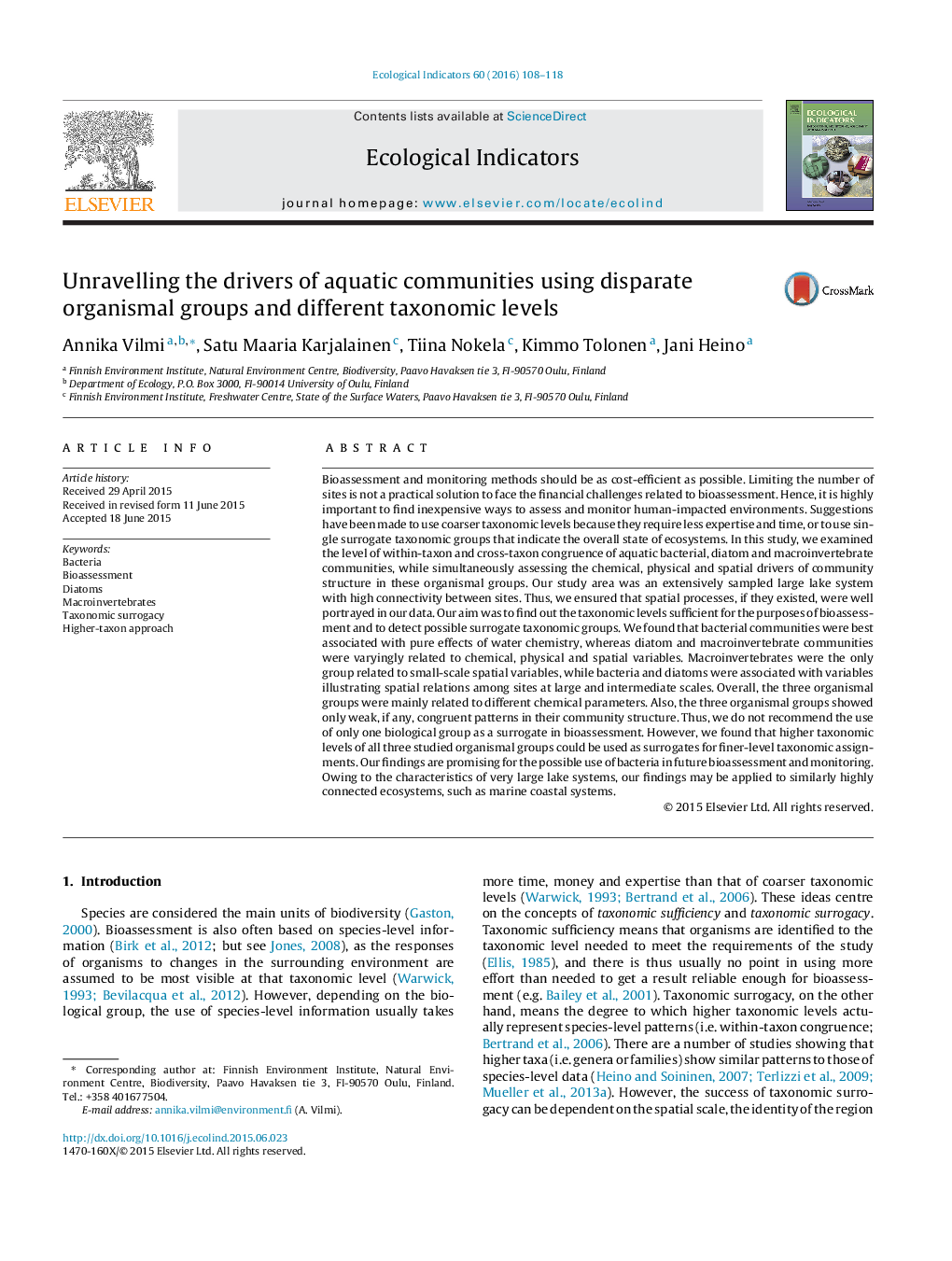| کد مقاله | کد نشریه | سال انتشار | مقاله انگلیسی | نسخه تمام متن |
|---|---|---|---|---|
| 6293997 | 1617141 | 2016 | 11 صفحه PDF | دانلود رایگان |
عنوان انگلیسی مقاله ISI
Unravelling the drivers of aquatic communities using disparate organismal groups and different taxonomic levels
ترجمه فارسی عنوان
تجزیه و تحلیل رانندگان جوامع آبزی با استفاده از گروه های ارگانیسم متفاوت و سطوح مختلف طبقه بندی
دانلود مقاله + سفارش ترجمه
دانلود مقاله ISI انگلیسی
رایگان برای ایرانیان
کلمات کلیدی
ترجمه چکیده
روش های سنجش بی رویه و روش های نظارت باید در حد امکان با هزینه ای موثر باشد. محدود کردن تعداد سایت ها یک راه حل عملی برای مقابله با چالش های مالی مربوط به ارزیابی زیست محیطی نیست. از این رو، بسیار مهم است که روش های ارزان قیمت برای ارزیابی و نظارت بر محیط های تحت تاثیر قرار گیرد. پیشنهاد شده است که از سطوح طبقه بندی گرانتر استفاده شود، زیرا آنها نیاز به تخصص و زمان کمتری دارند و یا از گروه های تکاملی جایگزین استفاده می کنند که نشان دهنده وضعیت کلی اکوسیستم ها است. در این مطالعه، سطح همبستگی داخل و تاکسون و همبستگی متقابل تاکسونهای جوامع باکتریایی، دیاتومه و ماکرومتری توبیتی را مورد بررسی قرار دادیم، در حالی که همزمان به ارزیابی رانندگان شیمیایی، فیزیکی و فضایی ساختار اجتماعی در این گروههای ارگانیزم پرداختیم. منطقه مطالعه ما نمونه ای از دریاچه بزرگ بود که ارتباطات زیادی بین سایت ها داشت. بنابراین، ما اطمینان دادیم که فرآیندهای فضایی، اگر آنها وجود داشته باشد، به خوبی در داده های ما به تصویر کشیده شده است. هدف ما کشف سطوح تاکسونومیکی کافی برای اهداف سنجش زیست محیطی و شناسایی گروه های طبقه بندی ممکن است. ما متوجه شدیم که جوامع باکتری بهتر از اثرات خالص شیمی در آب هستند، در حالی که جوامع دیاتوم و ماکرومونبولات به طور متفاوت با متغیرهای شیمیایی، فیزیکی و مکانی ارتباط دارند. ماکروبنبوتها تنها گروهی بودند که در ارتباط با متغیرهای فضایی کوچک بودند، در حالی که باکتری ها و دیاتومه ها با متغیرهایی که نشان دهنده روابط فضایی بین سایت های در مقیاس های بزرگ و متوسط بود مرتبط بودند. به طور کلی، سه گروه ارگانیزم به طور عمده با پارامترهای شیمیایی مختلف ارتباط داشتند. همچنین، سه گروه بنیادی تنها الگوهای ضعیف، اگر وجود داشته باشند، در ساختار جامعه خود نشان دادند. بنابراین، ما استفاده از تنها یک گروه بیولوژیکی را به عنوان یک جایگزین در ارزیابی بیولوژیکی توصیه نمی کنیم. با این حال، ما دریافتیم که سطوح تاکسونومی بالاتر از هر سه گروه ذهنی مورد مطالعه می تواند بعنوان جایگزین برای تخصیص تاکسونومیک سطح بالاتری استفاده شود. یافته های ما برای استفاده احتمالی باکتری ها در ارزشیابی و نظارت بر آینده امیدوار کننده است. با توجه به ویژگی های سیستم های بسیار بزرگ دریاچه، یافته های ما ممکن است به اکوسیستم های بسیار متصل به هم متصل شود، مانند سیستم های ساحلی دریایی.
موضوعات مرتبط
علوم زیستی و بیوفناوری
علوم کشاورزی و بیولوژیک
بوم شناسی، تکامل، رفتار و سامانه شناسی
چکیده انگلیسی
Bioassessment and monitoring methods should be as cost-efficient as possible. Limiting the number of sites is not a practical solution to face the financial challenges related to bioassessment. Hence, it is highly important to find inexpensive ways to assess and monitor human-impacted environments. Suggestions have been made to use coarser taxonomic levels because they require less expertise and time, or to use single surrogate taxonomic groups that indicate the overall state of ecosystems. In this study, we examined the level of within-taxon and cross-taxon congruence of aquatic bacterial, diatom and macroinvertebrate communities, while simultaneously assessing the chemical, physical and spatial drivers of community structure in these organismal groups. Our study area was an extensively sampled large lake system with high connectivity between sites. Thus, we ensured that spatial processes, if they existed, were well portrayed in our data. Our aim was to find out the taxonomic levels sufficient for the purposes of bioassessment and to detect possible surrogate taxonomic groups. We found that bacterial communities were best associated with pure effects of water chemistry, whereas diatom and macroinvertebrate communities were varyingly related to chemical, physical and spatial variables. Macroinvertebrates were the only group related to small-scale spatial variables, while bacteria and diatoms were associated with variables illustrating spatial relations among sites at large and intermediate scales. Overall, the three organismal groups were mainly related to different chemical parameters. Also, the three organismal groups showed only weak, if any, congruent patterns in their community structure. Thus, we do not recommend the use of only one biological group as a surrogate in bioassessment. However, we found that higher taxonomic levels of all three studied organismal groups could be used as surrogates for finer-level taxonomic assignments. Our findings are promising for the possible use of bacteria in future bioassessment and monitoring. Owing to the characteristics of very large lake systems, our findings may be applied to similarly highly connected ecosystems, such as marine coastal systems.
ناشر
Database: Elsevier - ScienceDirect (ساینس دایرکت)
Journal: Ecological Indicators - Volume 60, January 2016, Pages 108-118
Journal: Ecological Indicators - Volume 60, January 2016, Pages 108-118
نویسندگان
Annika Vilmi, Satu Maaria Karjalainen, Tiina Nokela, Kimmo Tolonen, Jani Heino,
